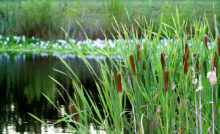Resorts Mining Their Courses for More Than Gold*


Is There Money Hidden on Your Golf Course?
Resort developers have traditionally viewed their property’s golf course as a necessary evil. But these days, they’re finding better management can yield cost savings and customer goodwill. Linda Parker Cole, writer for The Trades, shares some thoughts for those calling the shots, whether they’re responsible for multiple sites or an urban location with only an executive course. As a reader of Golf Course Trades, what recommendations might you add? Send us a note to Golf@TheTrades.com.
Implementing eco-friendly green practices at your resort is no longer just a way to stand out in the crowd. Environmental responsibility has become a standard that consumers expect all businesses in every industry to meet.
Green initiatives often deliver measurable gains in a resort’s return on investment. Given that golf courses and other green spaces often occupy the largest percentage of acreage on most resort properties, it makes sense that changing your turf or grounds maintenance practices will deliver some of the biggest bang for your buck return on your eco-friendly efforts.
Go Natural and Native. The Savings Can Be Incredible.
Golfers generally support increasing the naturalized areas on a golf course for both environmental benefits and aesthetic appeal, as long as doing so doesn’t have them scrambling through thick rough when looking for a lost ball. If you’re unsure where you could get away with reducing turf and increasing naturalization on your golf course, just equip golfers with GPS for a few weeks and track on-course activity, looking for the areas that get the least play or traffic.
Converting previously maintained areas of the course, such as roughs around tees, the transitional areas between holes and out-of-play embankments around water features, to low maintenance areas, saves on labor, chemicals, and irrigation. Naturalizing these areas with drought-tolerant native grasses or wildflowers enhances the visual appeal of the course, minimizes erosion, reduces the use and cost of chemicals, eliminates chemical runoff, creates wildlife habitats and, if designed strategically, even permits golfers to search for a stray ball.
Changing areas of your golf course or grounds from high maintenance to low or no maintenance won’t give guests the feeling that management is neglecting the course. Golf courses across the country, from small facilities to the legendary courses at Pinehurst, Chambers Bay, and other top destinations, have already made this move.
To be clear, reducing turf yields significant return. For example, Crandon Park Golf Course is a municipal facility that also provides golf for the Ritz-Carlton Key Biscayne. Course management there is implementing a plan to reduce turf and rough from 130 acres to approximately 88 acres by installing crushed stone and native plants appropriate to its South Florida coastal setting. Without impacting play in any way, the course will realize approximately $125,000 water use savings in the first year and a net reduction of water, fertilizers, pesticides, and labor-hours of approximately $350,000 annually.
Your board of directors would embrace cost reduction of this magnitude. Add signage pointing out how much water is being conserved or how many acres of songbird, bee, and butterfly habitat your efforts have created, and your resort will reap accolades from all its guests, even if they never see your balance sheet or learn how much money you’re really saving.
Speaking of Bees, Here’s the Buzz
Over the past five or more years, golf course managers, including those at many resort courses, have jumped at the opportunity to add beehives and pollen-rich vegetation to their properties. Why? Because nothing communicates more strongly that an environment is using chemicals and pesticides safely and prudently than the presence of thriving bee colonies.
Recognizing the appeal of bee-friendly branding, resorts that host beehives are featuring their harvested honey in spa treatments, signature cocktails and restaurant specialties. And free honey with a charming “harvested from our own hives” story to share makes for some pretty sweet marketing!
From Eco-Guilt… to Greenwashing
Bees are not the only buzz when it comes to environmental issues. Ecology is loaded with industry-specific terminology and countless buzz words.
Resort guests may not fully understand the scientific nuances of what it means to be biodegradable or ozone friendly, but they know they want their resort of choice to be doing these things. They react this way because in our society, eco-guilt is real. Essentially, eco-guilt describes the unpleasant feeling people get when they could have taken an environmentally responsible action but chose to do something in an easier, faster or more appealing way.
Vacationing at an environmentally green resort offsets the eco-guilt people feel from other aspects of their life. A long hot shower after a round of golf isn’t a guilty pleasure if the course played is known for conserving thousands of gallons of water annually. Driving a gas-guzzling sedan doesn’t feel as unacceptable if the destination is an eco-responsible resort.
When it comes to environmental issues, everyone cares a little, and most people genuinely care a lot. A 2018 Edelman study showed that 64 percent of consumers choose, switch, avoid or boycott a brand based on the brand’s position on societal issues.
However, inasmuch as embracing a green philosophy can endear a business to its client base, it can also alienate them. If brand marketers attempt to paint their products greener than they really are, or if their commitment to the environment comes across as disingenuous, then the buzzword used is “greenwashing.” Consumers are sensitive to inauthentic or inflated marketing crafted to play on their eco-guilt.
Connecting Your Green Golf Course to the Community
Few resort courses can fill all available tee times with guest rounds, which means serving area residents is extremely important. Courses that host local school events, offer a parents’ cocktail hour during junior lessons or provide kids activities during the parents’ golfing time attract and engage their local community. An environmentally responsible, family-friendly course earns status as a business that is connected to and cares about the locals, as opposed to being perceived as a resort that serves only outsiders.
But You Must Get the Word Out
For people to appreciate your green projects and be drawn to your resort, you must grab their attention. Resort guests, your prospective market, your local community, and the entire resort industry need to know how your projects benefit both them and Mother Earth. And the easiest way to get the word out happens to also be the easiest way to market.
Callaway Golf President and CEO, Oliver “Chip” Brewer recently spoke about today’s best strategies for communicating a brand’s message. “Marketing now is content creation,” said Brewer. “It’s social media; it’s real-time and constantly flowing. It’s engaging with the consumer and building a relationship directly… if you’re not doing that type of thing… you’re missing the boat and probably being left behind.”
Naturalizing your golf course, saving water or creating a butterfly and bee-friendly habitats is positive, uplifting and share-worthy content. Facebook, Instagram, blogs, media releases, and other online platforms provide resort marketers easy and affordable ways to communicate clickable, thumb-stopping content about a resort’s authentic green projects.
Whether you are saving a squirrel or saving the planet, share your story. Green initiatives are not just incredibly cost-effective; on social media, they’re gold!
*Excerpted from “Is There Money Hidden on Your Golf Course?” with permission, courtesy of May 2019 Resort Trades.
Linda Parker has been writing professionally since the 1980s. With clients in finance, sports, technology, change enablement, resorts, and nonprofit global initiatives, Linda helps organizations communicate their stories in meaningful ways to the people they most want to reach. She has authored, ghostwritten or contributed to more than a dozen nonfiction books. Linda is a member of the Authors Guild and the Golf Writers Association of America. You can connect with her at Linda@GlindaCreative.com
Recent Posts
Sir Nick Faldo and Himalayas Golf Launch ‘Golf in Small Spaces’ to Redefine Where the Game is Played
Golf is evolving, and Sir Nick Faldo is helping lead the charge. The six-time major…
Mark McCarel Joins EnP as Northeast Territory Sales Manager
Specialty fertilizer manufacturer EnP Investments is proud to welcome Mark McCarel as their Northeast Territory…
Heathrow Legacy Country Club’s Fazio Course Earns Audubon International Signature Sanctuary Certification
Audubon International—an environmentally focused non-profit organization offering members numerous certifications and conservation initiatives to protect…
South Carolina State Leaders Honor Green’s Superintendent Career
South Carolina’s House of Representatives today honored the career of golf course superintendent Chuck Green.…
Branson, Missouri: 5 Reasons Why it is a Must-Visit Travel and Golf Destination
Branson, Missouri, is booming as a must-visit destination for golf enthusiasts and travelers alike. Nestled…
Preview more than 1,000 rounds of golf available in GCSAA’s Rounds 4 Research online auction
The Golf Course Superintendents Association of America (GCSAA) Rounds 4 Research program offers golfers the…


